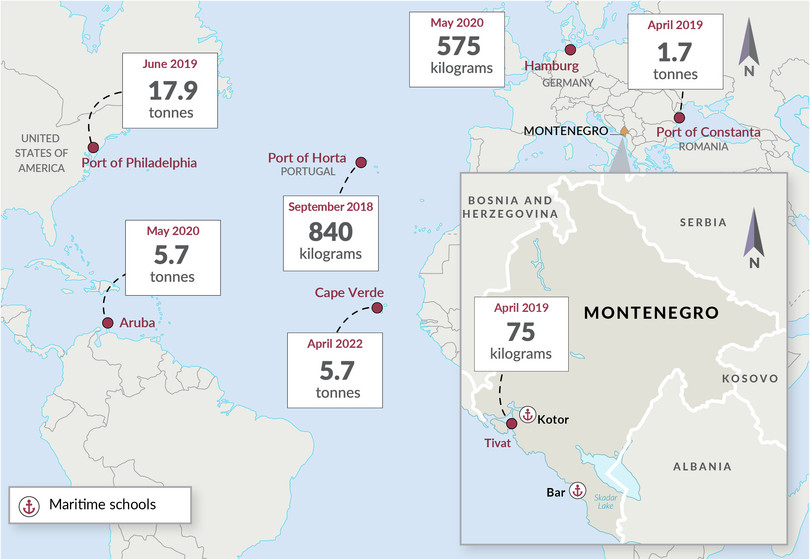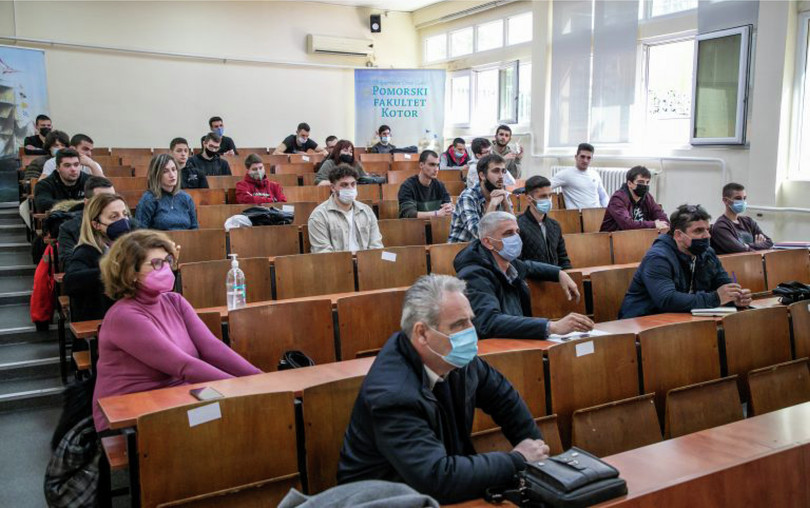Montenegrin sailors are involved in global drug trafficking schemes, damaging the reputation of Montenegro’s rich maritime tradition.
Montenegro is a small country with a population of only 621 000. Nevertheless, a disproportionate number of Montenegrin sailors have been arrested for smuggling drugs: between 2017 and 2021, police seized over 30 tonnes of cocaine worldwide in cases where criminals from Montenegro were involved.1 In April 2022, two Montenegrin sailors were arrested off the coast of Cape Verde as part of a crew smuggling 5 tonnes of cocaine from Brazil.2 Why are so many young men from the country involved in black markets, especially as sailors? This is a question that Mićan Andrijašević of the civil society organization Juventas set out to research in 2021,3 with support from the GI-TOC’s Resilience Fund. His findings were published in July 2022.4
Montenegro, situated on the Adriatic Sea, has a number of bays and harbours, as well as marinas and the port of Bar. It also has a proud maritime history. This is preserved, for example, by the Boka Navy – an NGO that keeps the seafaring tradition of the region alive through annual cultural events. In December 2021, UNESCO placed the Boka Navy on the Representative List of the Intangible Cultural Heritage of Humanity, highlighting its ‘memorial role for two centuries, preserving and promoting maritime history and tradition’.5
However, just two years earlier, Montenegrin sailors received a more dubious distinction: they were unofficially blacklisted by the Mediterranean Shipping Company (MSC) after a series of drug busts in which Montenegrin sailors were implicated. This included one of the largest seizures of cocaine in US history, when almost 20 tonnes were discovered on a ship in Philadelphia in June 2019.6 Investigations showed that crew members of the MSC-owned ship Gayane, including from Montenegro, helped load packages of cocaine onto the ship from speedboats that approached the vessel in the middle of the night. They stashed the cocaine in the cargo area, using fake seals to reseal the containers.7
The bust in Philadelphia was just one of a number in the past few years involving sailors from Montenegro. Some of the sailors work on container ships, while others are part of the crew of yachts or fishing boats. Loads may vary from a few kilograms to several tonnes. Small amounts may be concealed by individual sailors on deck whereas larger amounts involve a higher degree of sophistication and more people, including even the captain. In some cases, sailors may take on board drugs from small boats off the coast or throw drug-filled bags with a GPRS locator overboard when approaching the coast. They may also conceal drugs somewhere on the ship, for example by opening a container, hiding cocaine in it and closing it again with a fake seal.

Figure 1 Recent major cocaine busts worldwide involving Montenegrin sailors.
While criminals from the Western Balkans went abroad in the early 1990s, many young men from Montenegro went to sea. Some travelled routes that were used to smuggle cocaine from Latin America to Europe. As criminal groups from the Western Balkans became increasingly active in arranging such deals, Montenegrin sailors were in the right place at the right time to help facilitate such deliveries. Others were recruited by fellow Montenegrins (or other south-eastern Europe countries) who were higher up the ladder of crime. For example, Dragan ‘Fritz’ Dudić from Kotor, a close associate of Darko Šarić, the accused kingpin of a major Balkan drug smuggling organization, was a trained ship’s captain and recruited Montenegrin sailors. Dudić’s name came to light in 2009 when operation Balkan Warrior resulted in the seizure of over 2 tonnes of cocaine from a luxury yacht near Montevideo, Uruguay.8 In May 2010, Dudić was shot dead while sitting at a café in Kotor.9
According to Andrijašević’s research, it is hard to generalize about the profile of Montenegrin sailors involved in drug trafficking. He observed that:
Some are senior members of the crew, some more junior. Some have higher incomes, some lower. Some are older, some are younger. Some come from a maritime family tradition, some don’t. And some are from the coast, while some are from other parts of Montenegro. They are all targets of criminal clans that recruit sailors who in turn recruit their colleagues.
Drug trafficking can be a highly lucrative business. For example, the US Department of Justice assessed that one of the convicted Montenegrin sailors on the MSC Gayane with 11 years of work experience and an annual salary of US$108 000 could earn US$1 million for facilitating the smuggling operation, while his accomplices on board could earn US$50 000 to 60 000.10 High earnings are a solid lure for involving young sailors, according to Andrijašević.
The prevalence of Montenegrin seafarers involved in illicit activity seems well-known in society. According to a poll of high school students carried out in December 2021 in Montenegro, 41% of respondents in Kotor (where there is a maritime academy) said that they know at least one seafarer involved in drug trafficking, while 47% said that they would not report a case of illicit drug trafficking. That said, 92% of the surveyed students believed it wrong to use a weapon or force to take money or other goods from others, while 85% think that it is wrong to resell drugs.11
While drug trafficking is lucrative for some Montenegrin seafarers, it hurts the reputation of the law-abiding majority who are often deemed guilty by association. As a result, they can struggle to find jobs in some companies. The sooner the issue is addressed by the Montenegrin authorities, the better it will be for the reputation of the sailors, the country and its proud maritime tradition.
In the absence of a top-down approach, Juventas is working with young Montenegrins in maritime academies to warn them about recruitment and the dangers of organized crime. For example, from February to April 2022, Juventas organized integrity workshops for more than 200 future seafarers in maritime schools in Kotor and Bar.12 In April 2022, it fostered a discussion with law enforcement, the media and maritime schools on the role of Montenegrin seafarers in illicit activities through two public events in these cities. These events were covered by relevant local and national media.13 In June 2022, Juventas promoted two video features with research findings on its website and through social media.14 Together, these efforts contribute to improving the education, integrity and resilience of the next generation of Montenegrin sailors.

A discussion at the Faculty of Maritime Studies in Kotor on the involvement of Montenegrin sailors in drug trafficking.
Photo: Juventas via Juventas.me
Notes
-
Vlada Crne Gore – Biro za operativnu koordinaciju, SOCTA 2021: Procjena opasnosti od teškog i organizovanog kriminala u Crnoj Gori, March 2021, 28, https://wapi.gov.me/download/cf105122-2c9b-4816-b152-8487b5f59063?version=1.0. ↩
-
Cape Verdean police seize over 5 tonnes of cocaine, Africanews, 7 April 2022, https://www.africanews.com/2022/04/07/cape-verdean-police-seizes-over-5-tonnes-of-cocaine/. ↩
-
See http://juventas.me/. ↩
-
Juventas, KOMPAS: Crnogorsko pomorstvo u pogrešnom smjeru, 12 July 2022, http://juventas.me/publication/kompas-crnogorsko-pomorstvo-u-pogresnom-smjeru/. ↩
-
Cultural Heritage of Boka Navy Kotor: a festive representation of a memory and cultural identity, International Cultural Heritage, 18 December 2021, https://ich.unesco.org/en/RL/cultural-heritage-of-boka-navy-kotor-a-festive-representation-of-a-memory-and-cultural-identity-01727. ↩
-
Official account of the US Attorney’s Office, Eastern District of Pennsylvania, 18 June 2019, https://twitter.com/USAO_EDPA/status/1141046623159705602. ↩
-
Samir Kajosevic, US Sentences Montenegrin Over Tons of Cocaine Found on Ship, Balkan Insight, 14 April 2021, https://balkaninsight.com/2021/04/14/us-sentences-montenegrin-over-tons-of-cocaine-found-on-ship/. ↩
-
Bojana Jovanovic and Stevan Dojcinovic, Saric Case: from International Investigation to Second Judgement, KRIK, 5 December 2018, https://www.krik.rs/en/saric-case-international-investigation-second-judgement/. ↩
-
Death in Montenegro: Murders don’t help tourism, The Economist, 31 May 2010, https://www.economist.com/newsbook/2010/05/31/death-in-montenegro. ↩
-
Jeremy Roebuck, Seven years in prison for chief mate of cargo vessel where Philly feds found record 20 tons of cocaine, Philadelphia Inquirer, 10 June 2021, https://www.inquirer.com/news/msc-gayane-bosko-markovic-sentencing-crew-members-montenegro-20210610.html. ↩
-
Interview with Mićan Andrijašević, April 2022. ↩
-
Ibid. ↩
-
Juventas, Krijumčarenju droge i zloupotrebi pomoraca se mora stati na put, 7 April 2022, http://juventas.me/krijumcarenju-droge-i-zloupotrebi-pomoraca-se-mora-stati-na-put/. ↩
-
Juventas, Istraživanje o otpornosti Mladih, 20 June 2022, http://juventas.me/video-istrazivanje-o-otpornosti-mladih/; Juventas, Učešće crnogorskih pomoraca u krijumčarenju narkotika, 27 June 2022, http://juventas.me/video-ucesce-crnogorskih-pomoraca-u-krijumcarenju-narkotika/. ↩
